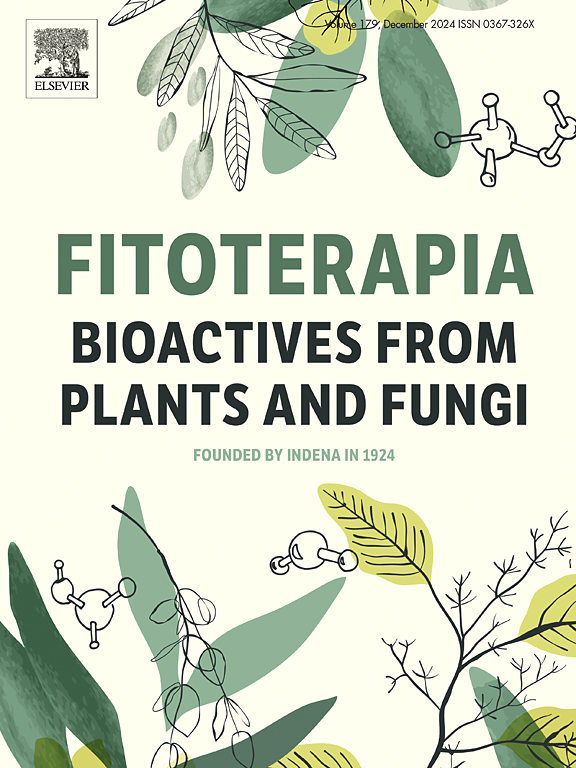Evaluation of the antihypertensive activity of the aqueous extract and the major flavonoid from Boldoa purpurascens Cav. leaves
IF 2.5
3区 医学
Q3 CHEMISTRY, MEDICINAL
引用次数: 0
Abstract
Boldoa purpurascens Cav., traditionally used in Cuba for hypertension, lacks ethnopharmacological validation. This study evaluated its aqueous extract and major flavonoid (4,5-dihydroxy-6,7-methylenedioxyflavonol-3-O-α-L-rhamnopyranosyl-(1 → 2)-β-D-xylopyranoside) for antihypertensive effects in a salt-induced hypertensive rat model. Sprague Dawley rats (n = 34) were divided into six groups: normotensive control, hypertensive untreated, hypertensive + enalapril (15 mg/kg/day), hypertensive + B. purpurascens extract (40 or 80 mg/kg/day), and hypertensive + flavonoid (3 mg/kg/day). Blood pressure was measured pre- and post-treatment, while a histopathological analysis assessed the impact on kidney, heart, and brain tissues. It was found that the extract (80 mg/kg/day) significantly reduced systolic (−8.0 mmHg) and diastolic (−5.2 mmHg) blood pressures, comparable to control (enalapril). The flavonoid showed milder effects (−0.7 mmHg systolic, −2.5 mmHg diastolic). Pathological findings revealed reduced myocardial hypertrophy and reversible renal tubular damage with flavonoid treatment, while brain edema and congestion were absent. It was concluded that B. purpurascens exhibits dose-dependent antihypertensive activity, likely mediated by flavonoids. The major flavonoid attenuated organ damage, suggesting therapeutic potential. Future studies should assess the presence of other bioactive compounds in the B. purpurascens extract, as well as clarify the mechanism of action.

紫荆水提物及主要黄酮类化合物的降压活性评价。叶子
紫癜病在古巴传统上用于治疗高血压,缺乏民族药理学验证。本研究在盐致高血压大鼠模型中评价了其水提物和主要类黄酮(4,5-二羟基-6,7-亚甲二氧黄酮醇-3- o -α- l-鼠李糖吡喃糖基-(1→2)-β- d -木pyranoside)的降压作用。将34只Sprague Dawley大鼠分为6组:正常对照组、高血压未治疗组、高血压+依那普利组(15 mg/kg/d)、高血压+紫癜B.提取物组(40或80 mg/kg/d)、高血压+黄酮类化合物组(3 mg/kg/d)。在治疗前后测量血压,同时组织病理学分析评估对肾脏、心脏和脑组织的影响。研究发现,与对照组(依那普利)相比,该提取物(80 mg/kg/天)显著降低了收缩压(- 8.0 mmHg)和舒张压(- 5.2 mmHg)。类黄酮表现出较温和的作用(- 0.7 mmHg收缩压,- 2.5 mmHg舒张压)。病理结果显示,黄酮类药物治疗后心肌肥厚减轻,肾小管损伤可逆,脑水肿和充血消失。由此可见,紫癜双歧杆菌具有剂量依赖性的抗高血压活性,可能是由类黄酮介导的。主要类黄酮减轻器官损伤,提示治疗潜力。未来的研究应评估紫癜提取物中是否存在其他生物活性化合物,并阐明其作用机制。
本文章由计算机程序翻译,如有差异,请以英文原文为准。
求助全文
约1分钟内获得全文
求助全文
来源期刊

Fitoterapia
医学-药学
CiteScore
5.80
自引率
2.90%
发文量
198
审稿时长
1.5 months
期刊介绍:
Fitoterapia is a Journal dedicated to medicinal plants and to bioactive natural products of plant origin. It publishes original contributions in seven major areas:
1. Characterization of active ingredients of medicinal plants
2. Development of standardization method for bioactive plant extracts and natural products
3. Identification of bioactivity in plant extracts
4. Identification of targets and mechanism of activity of plant extracts
5. Production and genomic characterization of medicinal plants biomass
6. Chemistry and biochemistry of bioactive natural products of plant origin
7. Critical reviews of the historical, clinical and legal status of medicinal plants, and accounts on topical issues.
 求助内容:
求助内容: 应助结果提醒方式:
应助结果提醒方式:


